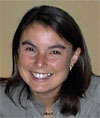A paper summarizing results from a five-year prospective study of NDEs conducted in a Welsh hospital in the United Kingdom. Interesting findings include pharmacological impact, differentiation from hallucinations, and effects of various conditions on the frequency of NDEs. The author will be giving a complete presentation of her study at the fall 2006 IANDS conference in Houston, including a case of the spontaneous healing of a congenital disorder after an NDE
A Long-Term Prospective Study to Investigate the Incidence and Phenomenology of Near-Death Experiences in a Welsh Intensive Therapy Unit
 [Introductory Note to Readers: Readers may find it helpful to know two points about Dr. Sartori's article.
[Introductory Note to Readers: Readers may find it helpful to know two points about Dr. Sartori's article.
- The acronym ”ITU” refers to an Intensive Therapy Unit which, in the United Kingdom, is the equivalent of an Intensive Care Unit in North America.
- On page 2, Sample 1 refers to all patients admitted to the ITU during an 11 month period, January-November, 1998. Sample 2 refers to all patients who experienced a cardiac arrest during a 5 year period, January, 1998 – January, 2003.]
At the time of commencement of this study, most NDE research was retrospective (Moody 1975, Ring 1980, Sabom 1982, Morse et al., 1985). A similar study (Parnia et al., 2001) was commenced at the same time as this study and followed a similar protocol, both projects being supervised by Dr Peter Fenwick. Further prospective studies have since been published (Parnia et al., 2001, van Lommel et al., 2001, Schwaninger et al., 2002, Greyson 2003).
The aim of this study was to establish if reductionist arguments of anoxia, hypercarbia or drug administration could explain the NDE. It was attempted to verify the out of body component by placing brightly coloured symbols (which could only be viewed from an out of body perspective) on top of the cardiac monitor at each patient’s bedside.
The pilot study was undertaken during the summer of 1997. The official data collection began in January 1998 and was completed in January 2003.
Method
All data collection, interviews, transcribing and data analysis were undertaken by the author. Each patient interviewed was simply asked ‘Do you have any recollection of anything during the time that you were unconscious?’
If it was apparent that a patient had undergone a NDE or OBE they were interviewed in-depth once the research had been explained and their written consent obtained. They were allowed free narrative of the experience and then completed The Greyson NDE Scale (Greyson 1983). This was followed by an in-depth questionnaire based on that used by Ring (1980). It was also evident that many patients had reported hallucinations. Twelve of these cases were documented in order to contrast the differences between NDEs and hallucinations. Drugs administered and the blood results taken at the time of the medical emergency were documented and later analysed.
Penny Sartori has worked as a nurse at The Intensive Therapy Unit, Morriston Hospital, Swansea, UK for the past 13 years. The frequent deaths of patients she encountered made Dr. Sartori question 'What happens when we die'. She read about NDEs and in 1997 decided to undertake her own research by conducting a long term prospective study (the UKs first long term study). The supervisors for the research were Dr Peter Fenwick and Professor Paul Badham. The prospective study formed part of a much bigger research project into NDEs for which Dr. Sartori was awarded a PhD in 2005 at the University of Wales, Lampeter.
"Reprinted with permission of the Network Review, published by the Scientific and Medical Network (www.scimednet.org )."
